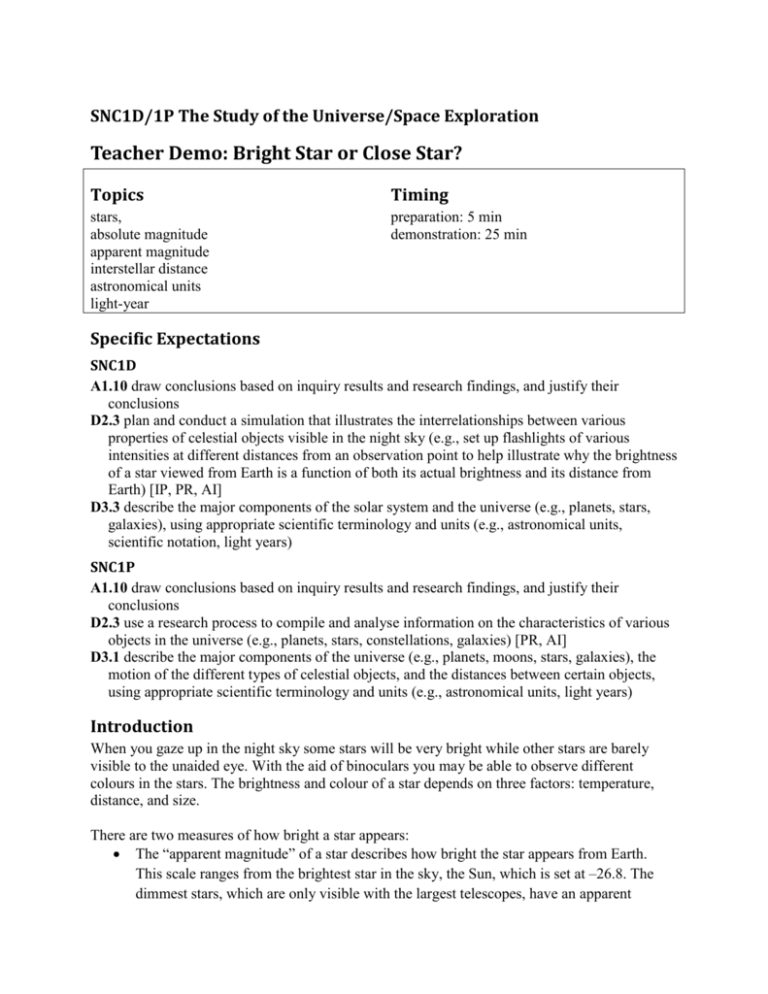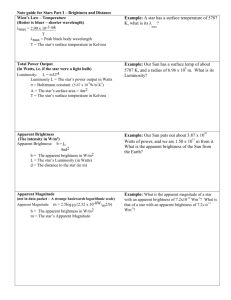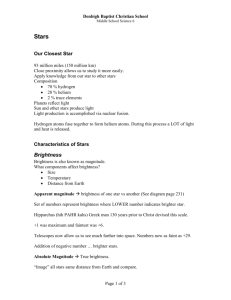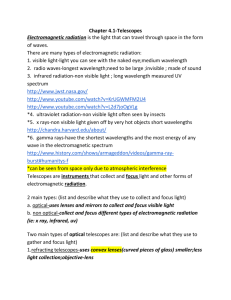docx - STAO
advertisement

SNC1D/1P The Study of the Universe/Space Exploration Teacher Demo: Bright Star or Close Star? Topics Timing stars, absolute magnitude apparent magnitude interstellar distance astronomical units light-year preparation: 5 min demonstration: 25 min Specific Expectations SNC1D A1.10 draw conclusions based on inquiry results and research findings, and justify their conclusions D2.3 plan and conduct a simulation that illustrates the interrelationships between various properties of celestial objects visible in the night sky (e.g., set up flashlights of various intensities at different distances from an observation point to help illustrate why the brightness of a star viewed from Earth is a function of both its actual brightness and its distance from Earth) [IP, PR, AI] D3.3 describe the major components of the solar system and the universe (e.g., planets, stars, galaxies), using appropriate scientific terminology and units (e.g., astronomical units, scientific notation, light years) SNC1P A1.10 draw conclusions based on inquiry results and research findings, and justify their conclusions D2.3 use a research process to compile and analyse information on the characteristics of various objects in the universe (e.g., planets, stars, constellations, galaxies) [PR, AI] D3.1 describe the major components of the universe (e.g., planets, moons, stars, galaxies), the motion of the different types of celestial objects, and the distances between certain objects, using appropriate scientific terminology and units (e.g., astronomical units, light years) Introduction When you gaze up in the night sky some stars will be very bright while other stars are barely visible to the unaided eye. With the aid of binoculars you may be able to observe different colours in the stars. The brightness and colour of a star depends on three factors: temperature, distance, and size. There are two measures of how bright a star appears: The “apparent magnitude” of a star describes how bright the star appears from Earth. This scale ranges from the brightest star in the sky, the Sun, which is set at –26.8. The dimmest stars, which are only visible with the largest telescopes, have an apparent magnitude of 25. The faintest stars visible by the naked eye have an apparent magnitude of 5.5. A decrease of 1 on the scale represents a 2.5 times increase in the apparent brightness. The absolute magnitude of a star is the measure of brightness of a star if it were at a distance of 32.6 light years (ly) from an observer. By placing all stars at this distance, the true brightness of the stars can be compared. We know that the apparent magnitude of the Sun is the brightest at –26.8. However, when using the absolute magnitude scale the Sun would be barely visible to the naked eye, with a reading of 4.8. Materials 2 identical low-wattage flashlights high-wattage flashlight Safety Considerations Students should not look directly into any flashlight for extended periods of time. Procedure 1. Predict Show the following image of Orion (Fig.1). Have students predict which star is closest and which star is furthest away. (Image used with permission from NASA) Fig.1 Three of the stars in the constellation Orion Have all the students gather on one side of a large room. 2. Observe Demonstrate to the students that two luminous objects with the same brightness look different when viewed at different distances. Place two identical low-wattage flashlights on desks―one close to the students and one further away. Turn on both flashlights and darken the room. Invite the students to compare the brightness of the flashlights. 3. Similarly, show students that two luminous objects of different brightnesses look different when viewed from the same distance away. Hold one low-wattage flashlight and one higher-wattage flashlight side by side, pointing towards the students. Turn on both 4. 5. 6. 7. 8. flashlights and darken the room. Invite the students to compare the brightness of the flashlights. Next, demonstrate how brightness can be deceiving when we view objects at different distances. Place a low-wattage flashlight on a desk close to the students, pointing toward them. Place a higher-wattage flashlight on a desk further from the students, also pointing toward them. It should be far enough away that it appears less bright than the low-wattage flashlight. Turn on both flashlights and darken the room. Invite the students to compare the brightness of the flashlights. Now move the larger flashlight closer. What happens to the brightness? Set the larger flashlight at a distance where the two flashlights appear to have the same brightness: where the apparent magnitudes are the same. Ask students how they might determine which one is bigger or closer, if they could only see the two points of light. Explain Ask students to identify the two factors affecting brightness illustrated in the demo. Relate the demonstration to the stars in Fig.1. Rigel is further from Earth than is Betelgeuse. What could students infer about the brightness of Rigel? Encourage them to consider both temperature and energy. Disposal If the flashlights are used for this demo, turn them off and remove the batteries to be reused at a later date. What happens? When the larger flashlight is farther away, the light reaching the observer appears dimmer because its light is spread out over a greater area. The smaller flashlight, which is closer, is brighter as its light is spread out over a lesser area. How does it work? The two factors affecting brightness are the energy of the light (which affects its temperature and colour) and the distance from the observer. Sometimes the brightest-looking stars are not actually the brightest, and sometimes the closest-looking stars are not the closest. Light energy dissipates (spreads out) as it travels from its source. You could briefly discuss the idea of the inverse square law that light obeys: as distance from the light source increases (Fig.2), the area covered by that light increases with the square of the distance. Since the same quantity of light energy is spread over a greater area, the brightness at any particular point is less. (See the reference below for further details.) Consequently far-away luminous objects appear dimmer than nearby objects that emit the same quantity of light energy. Source: http://www.math.lsa.umich.edu/mmss/coursesONLINE/Astro/Ex1.2/ Fig.2 The area covered by light increases as the square of its distance from the source. A smaller proportion of light from a distant star reaches the eye of an observer than does the proportion of light from a nearby star. The apparent brightness of stars illustrated in this demo is affected both their size (which often correlates to their energy output) and their distance from the earth. Betelgeuse (the star in the upper left of Orion) is at a distance of approximately 642 ly, while Rigel (in the lower right) is at a distance of approximately 776 ly. The star Bellatrix (which appears dimmest) is the closest at approximately 245 ly. Both size and distance, therefore, affect the brightness of a star. Teaching Suggestions/Hints 1. 2. Try different flashlights and distances to ensure that the high-wattage one, when placed at the far end of the room, is dimmer than the smaller one (in Step 3). You should also determine the distance the larger flashlight should be placed such that the apparent magnitudes appear the same. You could also use a photometer to record the quantity of light (in W/m2) being gathered from the different luminous or reflective objects. Next Steps The effects of temperature and brightness may be discussed. Betelgeuse is 15 times bigger (in radius) than Rigel and it is closer by more than 100 ly. Why is Rigel brighter? The explanation is that Betelgeuse is a red supergiant star that has evolved off the main sequence. This means that it has burned through the hydrogen fusion process and it is currently fusing heavier elements, producing less energy overall. It is therefore dimmer than might be expected of a star of its size. Its surface temperature is relatively cool at about 3500 K. Rigel is a blue giant with a surface temperature of about 11000 K. You may choose to discuss colour next, considering the wavelength (and relative energy) of each of the different colours of light. Extension: Introduce the inverse square law to the students so they can explore quantitatively how radiation energy decreases with the distance from the source. Additional Resources 1. 2. Windows to the Universe – ‘Magnitude’ as a measure of the brightness of stars: http://www.windows2universe.org/the_universe/Stars/magnitude_scale.html Earth Sky –Sirius and the brightness of stars: http://earthsky.org/brightest-stars/sirius-thebrightest-star









